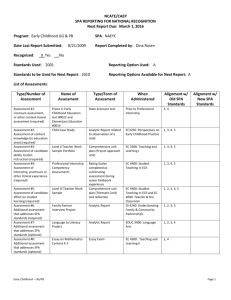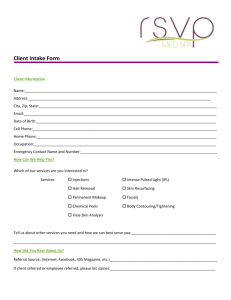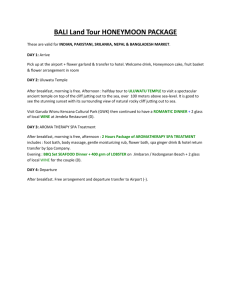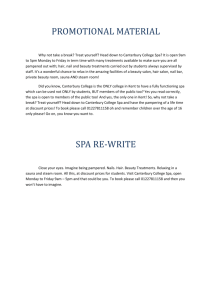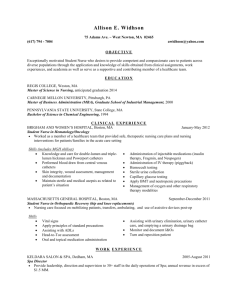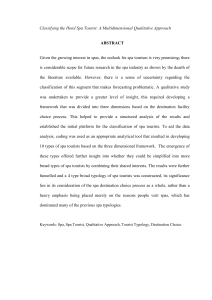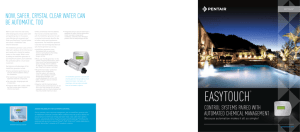PH Minus for spa pools
advertisement
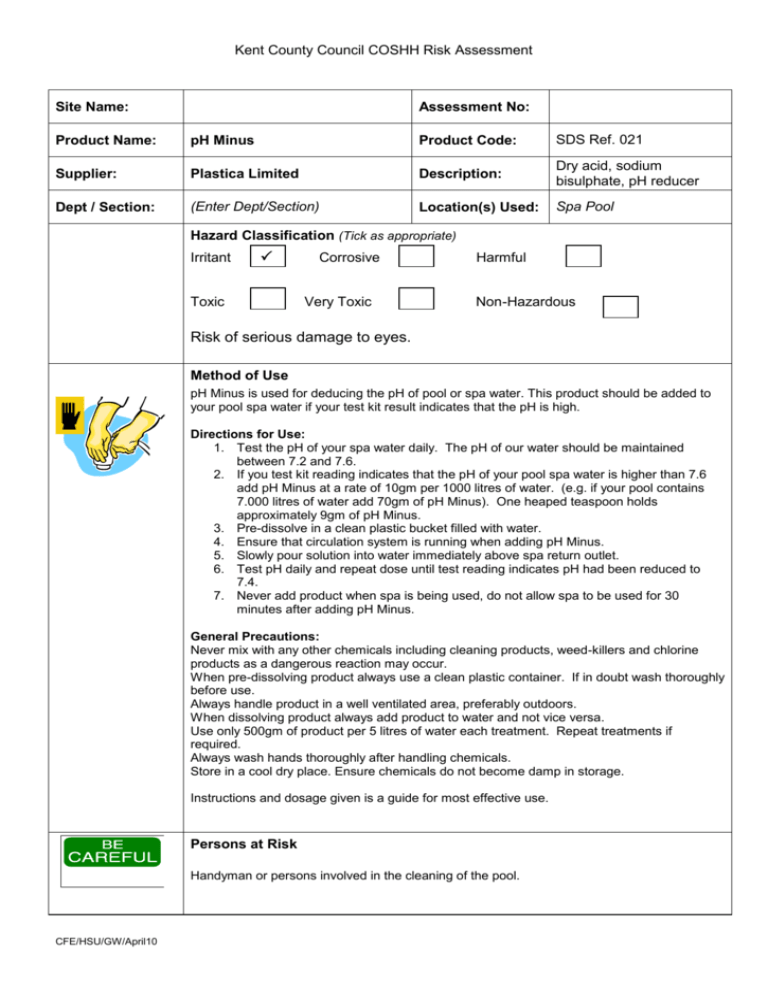
Kent County Council COSHH Risk Assessment Site Name: Assessment No: Product Name: pH Minus Product Code: SDS Ref. 021 Supplier: Plastica Limited Description: Dry acid, sodium bisulphate, pH reducer Dept / Section: (Enter Dept/Section) Location(s) Used: Spa Pool Hazard Classification (Tick as appropriate) Irritant Toxic Corrosive Very Toxic Harmful Non-Hazardous Risk of serious damage to eyes. Method of Use pH Minus is used for deducing the pH of pool or spa water. This product should be added to your pool spa water if your test kit result indicates that the pH is high. Directions for Use: 1. Test the pH of your spa water daily. The pH of our water should be maintained between 7.2 and 7.6. 2. If you test kit reading indicates that the pH of your pool spa water is higher than 7.6 add pH Minus at a rate of 10gm per 1000 litres of water. (e.g. if your pool contains 7.000 litres of water add 70gm of pH Minus). One heaped teaspoon holds approximately 9gm of pH Minus. 3. Pre-dissolve in a clean plastic bucket filled with water. 4. Ensure that circulation system is running when adding pH Minus. 5. Slowly pour solution into water immediately above spa return outlet. 6. Test pH daily and repeat dose until test reading indicates pH had been reduced to 7.4. 7. Never add product when spa is being used, do not allow spa to be used for 30 minutes after adding pH Minus. General Precautions: Never mix with any other chemicals including cleaning products, weed-killers and chlorine products as a dangerous reaction may occur. When pre-dissolving product always use a clean plastic container. If in doubt wash thoroughly before use. Always handle product in a well ventilated area, preferably outdoors. When dissolving product always add product to water and not vice versa. Use only 500gm of product per 5 litres of water each treatment. Repeat treatments if required. Always wash hands thoroughly after handling chemicals. Store in a cool dry place. Ensure chemicals do not become damp in storage. Instructions and dosage given is a guide for most effective use. Persons at Risk Handyman or persons involved in the cleaning of the pool. CFE/HSU/GW/April10 Kent County Council COSHH Risk Assessment Action In Case Of Emergency (Spillage, uncontrolled release, fire) Personal Protection: Observe normal standards for handling chemicals: Avoid breathing dust; wash hands before breaks and after work. Spillages: Adhere to personal protective measures. Take up mechanically (e.g. sweep or vacuum up) into a suitable container; dispose of as prescribed. Wash affected area to drain with a lot of water. Fire: This material is not very likely to burn. Extinguishing media: Small fires: dry chemical, CO2, water spray or standard foam. Large fires: water spray, fog or standard foam is recommended. Special exposure hazards: The thermal decomposition products released (e.g. SO2) should be considered toxic if inhaled. Protective Equipment: Wear self-contained breathing apparatus. Further Information: Cool endangered containers with water (to prevent container explosion). EMERGENCY CONTACT NUMBERS: 09062 655005 (24 hr) General Precautions & Personal Protection (e.g. warning signs, ventilation, personal hygiene / cleanliness, protective clothing) Engineering Controls: Ensure adequate ventilation of working area. Eye Protection: Safety goggles or face shield (i.e. EN 166 approved) Hands: Natural rubber latex gloves(also consider your own risk assessment; e.g. breakthrough times, rates of diffusion and degradation, tasks undertaken) Skin Protection: Overalls or apron Respiratory protection: When dusty conditions are encountered, wear a NIOSH/OSHA full face respirator with chlorine cartridge and dust pre-filter. WEL: Monitoring of the workplace should be considered in accordance with EH40 (or equivalent) controls. L TEL: (8 hour TWA): ppm 10 mg/m³ Total inhalable dust (EH40/2005) L TEL: (8 hour TWA): ppm 4 mg/m³ Respirable dust (EH40/2005) Ecological/Toxicological Information Ecological Acute toxicity: Degradability: LC50 No data available Toxicological Acute toxicity: LD50 rat (oral) mg/kg Daphnia magna 190mg/1 48 hours no data available Stability: Stable under normal conditions of handling. Conditions to Avoid: Contact with water – corrosive solution formed. Material to avoid: The product is incompatible with many metals. Hazardous reactions: Reaction of aqueous solution with metals causes release of flammable hydrogen with the possibility of explosive air mixtures being formed. Hazardous decomposition products: Oxides of sulphur. CFE/HSU/GW/April10 Kent County Council COSHH Risk Assessment Emergency First Aid Treatment (Eyes, skin, swallowed, inhaled) Eyes: Immediately wash out eye thoroughly with plenty of water until irritation subsides. If necessary (e.g. irritation persists), consult an eye specialist/ophthalmologist. Skin: Remove contaminated clothing. Rinse skin affected immediately with plenty of water for at least 15 minutes. If necessary, seek medical advice. Inhalation: Remove casualty to fresh air and provide warmth and rest. If necessary, seek medical advice. Ingestion: Allow the patient to vomit on his own accord. Give copious water to drink. Handling, Storage, Disposal & Transport Information Handling: Handle in accordance with good hygiene and safety practice. Storage: Ensure adequate ventilation of the storage area. Keep containers tightly closed and dry, away from foodstuff. Disposal: In accordance with National and Local Authority Regulations, e.g. The Hazardous Waste (England and Wales) Regulations 2005. Other: Contaminated packaging: Treat empty containers in the same way as the product or if possible wash out thoroughly and recycle. Health Surveillance / Exposure Monitoring Not required in this situation Assessment of Risk Low Medium High Notes / Further Action NEVER USE CHEMICALS THAT YOU ARE NOT TRAINED OR AUTHORISED TO USE. Assessment By Date: Next Review Date: (Name & Job Title) Review Record Date CFE/HSU/GW/April10 Reviewed By Result / Action Taken
